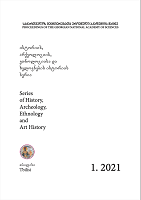“კლიტენი იერუსალჱმისანი”, რომელთაც ერთხანს ქართველები ფლობდნენ
THE “KEYS OF JERUSALEM” OWNED ONCE BY THE GEORGIAN MONKS
Author(s): Mzia MarsagishviliSubject(s): Cultural history, Social history, 13th to 14th Centuries, 15th Century, Sociology of Religion, History of Religion
Published by: საქართველოს მეცნიერებათა ეროვნული აკადემიის გამომცემლობა
Keywords: Church of the Holy Sepulchre; Georgian monks; „Keys of Jerusalem”;
Summary/Abstract: An entry made by a traveler Felix Fabri between 1480 and 1483, discov-ered by Grigol Peradze, states that the Church of Holy Sepulchre in Jerusalem had three entrances and one of them, not long before Fabri’s visit, belonged to the Georgians.According to a Georgian chronicle “Dzegli Eristavta” (XIV-XV cc.) the Georgians acquired keys of the main Christian church at the beginning of XIV century. To show the importance of this acquisition they were referred to as the “Keys of Jerusalem”.When working on the manuscripts of the Cross Monastery in Jerusalem Alexander Tsagareli (1883) and Nicolas Marr (1902) paid attention to an in-terlineation by Beena Cholokashvili, the rector of the Monastery, about the restoration of a door of the Church of Holy Sepulchre which he carried out personally in 1514. That information is confirmed by an Arabic source of the same year found and translated by Gocha Japaridze at the end of XX century.It is clear that Beena Cholokashvili meant the door which had been in his times still controlled by the Georgian monks: he would never restore someone else’s property in the Church where different Christian denominations defend-ed jealously their right for every square inch of the surface. It was considered by Georgian historiography that the “Keys of Jerusalem” owned by the Georgian monks referred to the main (southern) entrance of the Church. But using the “hidden information” of the historical sources it became evident that the door under consideration (with “small yard having the bolted gate”) was situated in the western part of the Church from where there was the shortest way to the Greek Orthodox Patriarchy. As the author hadn’t a possibility to revise personally the correctness of the findings based exclusively on the historical sources, upon her request the Abbot of the Church of the Twelve Apostles at Capernaum (Galilee) Archimandrite Irinarchos, to whom she is most grateful, confirmed with a photo-graph (fig. 3), that “small yard”, mentioned in medieval sources, still exists, the entrance to the Church is walled up, but the stone frame of the door survived. According to the record by a monk Lavrenti Gogeladze, he read Georgian inscription on that door made of “cypress tree” in 1806. Most probably the door perished in the fire of 1808 which devastated the Church and the entrance from that side had been walled up during the subsequent restoration.
- Issue Year: 2021
- Issue No: 1
- Page Range: 5-34
- Page Count: 30
- Language: Georgian

